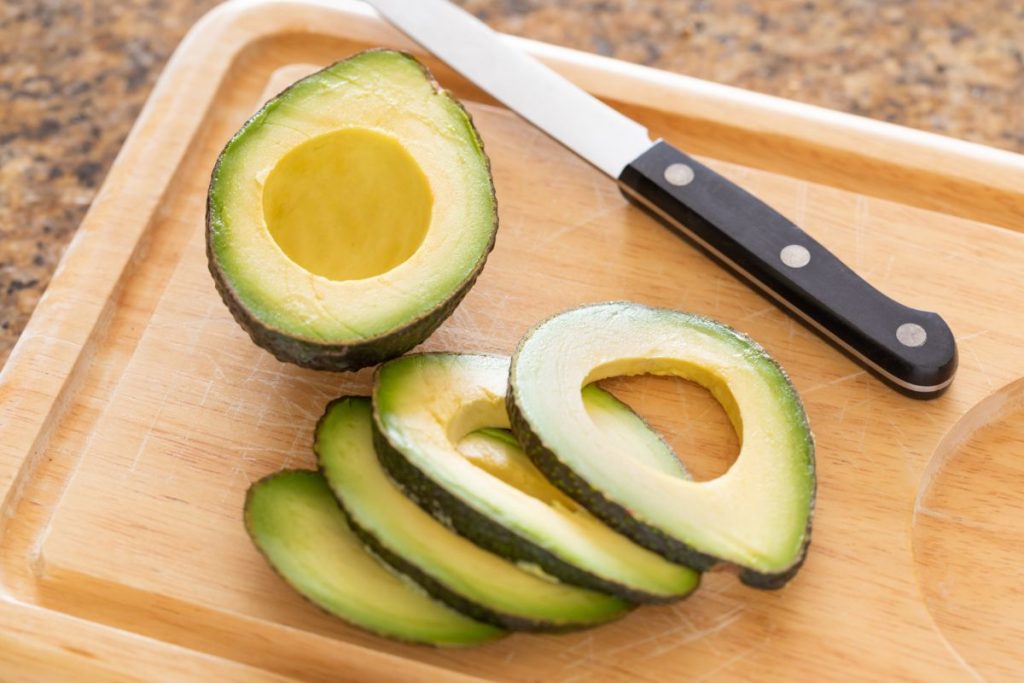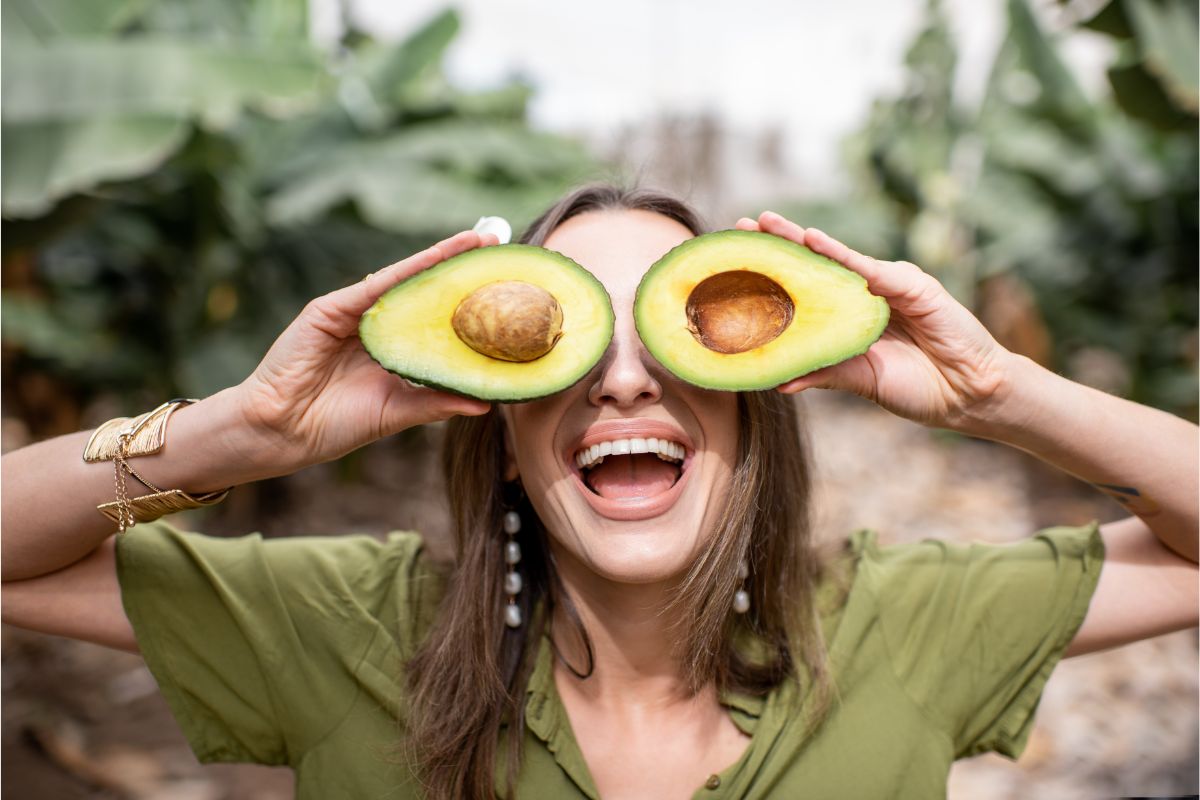The most popular way of dehydrating avocados is using a dehydrator. Remove the avocado from the skin and discard the pit. Cut the avocado into small, uniform slices. Set the dehydrator temperature to 135°F (57°C) and let it run until the avocado slices are dehydrated, which can take anywhere from 8 to 12 hours.
Table of Contents
1. Dehydrating Avocados: Food Dehydrator Method
The most common and well-known way to dehydrate avocados is to use a dehydrator. This is the quickest and most efficient dehydration process, taking only a few hours.
If you have an air fryer but not a dehydrator, you can use most air fryers to dehydrate. Simply look up instructions and tools needed for your specific air fryer.
To dehydrate avocados using a traditional dehydrator, you can follow these steps:
- Take your room-temperature avocado and cut it into thin slices, about 1/8 inch thick.
- Place the slices in a single layer on a dehydrator tray.
- Set the dehydrator temperature to 135°F (57°C) and let it run until the avocado slices are dehydrated, which can take anywhere from 8 to 12 hours, depending on the dehydrator and the thickness of the slices.
- Check the slices every few hours to see if they are dry, and rotate the trays.
- Once they are dry and leathery, with an appearance similar to fruit leather, remove the slices from the dehydrator and allow them to cool completely.
- Store the dehydrated avocado slices in an airtight container or resealable plastic bag in a cool, dark place.
Dehydrating avocados can help if you want to keep them for long-term storage, but the texture may change and become chewy and less creamy than fresh avocados.

2. Dehydrating Avocads: Air Drying Method
Air drying avocados is one of the simplest methods for dehydrating avocados. This method works best in a dry and warm environment. It is helpful to lay the avocados on a drying rack or dehydrating screen so that they get proper air circulation and can air-dry evenly.
To air-dry avocados, you can follow these steps:
- Cut the avocado in half and remove the pit.
- Place the avocado halves cut-side up on a paper towel to absorb excess moisture.
- Leave the avocados to air dry in a warm, dry place for a few days or until the cut surfaces have become firm and slightly wrinkled.
- Store the air-dried avocados in an airtight container until ready to use.
You should note that air-drying avocados can help prolong their shelf life, but it won’t prevent them from eventually going bad. You should still use or freeze them within a few days.
3. Dehydrating Avocado: Oven-Drying Method
Oven drying is a method of dehydrating used to extend the shelf-life of food for people interested in long-term food preservation. Many people who do not have or want to purchase a traditional dehydrator choose to use this method of dehydrating their food.
To oven-dry avocados, follow these steps:
- Preheat the oven to 200°F (93°C), or the lowest temperature your oven allows.
- Cut the avocado into thin slices, about 1/8 inch thick.
- Place the slices on a baking sheet lined with parchment paper or a silicone mat.
- Bake the slices in the oven for 4 to 6 hours, or until they are dry and slightly leathery.
- Check the slices every hour and rotate the baking sheet if necessary to ensure even drying.
- Once they are dry, remove the slices from the oven and let them cool until they are crispy.
- Store the oven-dried avocado slices in an airtight container or resealable plastic bag in a cool, dark place.
When you oven-dry avocados it can be a slower process than using a dehydrator. It’s important to keep a close eye on the avocados and monitor them regularly to avoid over-drying, which can cause them to become too brittle and lose their flavor and nutrients.

4. Dehydrating Avocado: Microwave Drying Method
Most people have a microwave and it can be used for a lot more things than people realize, even dehydrating! Microwave drying avocados can be done but should be your last resort as it does not produce results as well as alternative methods.
If you want to use a microwave to dehydrate avocados, here’s how to do it:
- Cut the avocado into thin slices, about 1/8 inch thick.
- Place the slices on a microwave-safe plate lined with paper towels to absorb any excess moisture.
- Cover the plate with another layer of paper towels to prevent the slices from splattering in the microwave.
- Microwave the slices on high in 1-minute intervals, flipping the slices and re-covering with paper towels after each interval until they are dry and slightly leathery. This could take anywhere from 2 to 8 minutes, depending on the microwave and the thickness of the slices.
- Be sure to monitor the slices closely and stop the microwave if they start to become too dry or brown due to oxidation.
- Once they are dry, remove the slices from the microwave and let them cool completely.
- Store the microwave-dried avocado slices in an airtight container or resealable plastic bag in a cool, dark place.
You should keep in mind that using a microwave to dehydrate avocados is not recommended, as the high heat and uneven heat distribution can cause the avocados to become tough and rubbery, affecting the final product. It can also cause avocados to lose some of their flavor and nutritional value.
5. Dehydrating Avocado: Sun Drying Method
If you live in a sunny and warm climate, you can use the sun to dry your avocado slices. This method takes the longest, but it’s also the most natural and eco-friendly way of preserving all the health benefits of avocado.
Sun-drying avocado is a traditional method of preserving food, but it can be challenging to achieve consistent results and can pose food safety risks if not done correctly.
Here’s how to sun-dry avocados:
- Cut the avocado into thin slices, about 1/8 inch thick.
- Place the slices on a clean, flat surface that has been covered with a layer of cheesecloth to prevent contamination.
- Place the surface in a sunny, well-ventilated area where the temperature will remain between 95°F (35°C) and 115°F (46°C) for several days.
- Turn the slices every few hours to ensure even drying and to prevent mold or spoilage.
- Continue to dry the slices until they are dehydrated and slightly leathery, which could take anywhere from 2 to 5 days, depending on the weather conditions.
- Store the sun-dried avocado slices in an airtight container or resealable plastic bag in a cool, dark place.
If you choose to sun dry avocados, remember that it can be a slow and unpredictable process, and it’s important to monitor the slices regularly to ensure that they are drying properly and not becoming contaminated. Using a dehydrator or oven to dry avocados provides a more controlled and consistent drying environment.
What are the Benefits of Dehydrating an Avocado?
There are several amazing benefits to dehydrating avocados. Consider it a snack revolution!
- Dehydrating avocado helps preserve it for a longer period, so you can enjoy it even when it’s out of season. No more throwing away mushy avocados!
- Dehydrated avocado slices make a crunchy and delicious snack that’s perfect for the on-the-go person. It’s also a great addition to your trail mix, smoothies, and salads.
- Dehydrated avocados have a crispy texture, which makes them a fun and unique topping.
- Um, a portable food item? Say no more! I love a snack that I can take anywhere and dehydrated avocado is that! It is lightweight and easy to transport, making it a great option for hiking, camping, or traveling.
- Many people are trying to live more eco-friendly lives nowadays. If protecting the environment is important to you, then consider dehydrating avocados. This is a great way to reduce food waste and minimize packaging.
- It can be hard to get all the nutrients you need into your daily diet. Avocado is packed with healthy fats, antioxidants, fiber, and essential vitamins and minerals.
- If you love a customizable snack, that is another reason to try dehydrating your avocados. You can add any seasoning or spice to your dehydrated avocado to make it even more delicious. Think everything bagel seasoning and ranch powder!
Creative Ways to Use Dehydrated Avocado
This crispy, crunchy superfood has endless potential! Here are a few ideas to get you started:
Trail Mix
Add dehydrated avocado to your favorite trail mix for a unique and delicious twist. Yum! This is a perfect snack for any time, and adding a bit of avocado adds some protein, too!
Salad Topper
If you are craving a cobb salad but do not have any fresh avocado on hand, try using this recipe and sprinkling some dehydrated avocado over the salad to add crunch and flavor.
Smoothie Booster
Blending dehydrated avocado into your smoothie is a great idea for an extra boost of fiber, healthy fats, and flavor. Try using a fresh smoothie recipe like this and add your dehydrated avocado. Don’t like tropical fruits? Try blueberries, raspberries, leafy greens, zucchini, or other veggies you love to make an easily customizable and healthy drink!
Avocado Chips
Ditch the potato chips and try some delicious and nutritious avocado chips instead. Simply sprinkle some sea salt and your favorite spices for added flavor. These are a heart-healthy, keto-friendly snack that is not only delicious but nutritious. Ditch that bag of potato chips and use your dehydrator to make crispy avocado chips instead!
These creative ideas are just the tip of the iceberg! Get creative and have fun with dehydrated avocado. It’s time to add excitement to your snacking routine and enjoy the many benefits of this superfood.
What is the Shelf Life of Dehydrated Avocado?
The shelf life of dehydrated avocado can vary, but generally, it can last several months to a year if stored properly. Dehydrated avocados should be stored in an airtight container in a cool, dry place, such as a pantry or cupboard.
Exposure to moisture, heat, or light can cause the dehydrated avocado to spoil, which is why refrigeration isn’t recommended. It’s important to keep it stored properly to ensure its freshness and longevity.
You should aim to consume the dehydrated avocado within a reasonable time frame, such as a few months to ensure optimal taste and quality.
How to Make Dried Avocado Powder
Making dehydrated avocado powder is a straightforward process that can be done using a dehydrator or an oven. Here is a basic recipe for making dried avocado powder:
Ingredients:
- Ripe avocados
- Blender or food processor
- Dehydrator or oven
- Parchment paper
Instructions:
- Cut the avocados in half and remove the pit. Scoop out the flesh into a blender or food processor.
- Blend the avocado until it forms a smooth puree.
- Line a dehydrator tray or baking sheet with parchment paper.
- Using a spoon or piping bag, spread the avocado puree into thin, even layers on the parchment paper.
- Dehydrate the avocado puree in a dehydrator at 115°F (46°C) for 12-24 hours or in an oven set to the lowest temperature, with the door slightly open, for 8-12 hours or until the puree is completely dry and crumbly.
- Once the avocado is dry and crumbly, remove it from the dehydrator or oven and let it cool.
- Grind the dried avocado in a blender or food processor until it forms a fine powder.
- Store the avocado powder in an airtight container in a cool, dry place for up to 6 months.

What is the Texture of Dehydrated Avocado?
The texture of dehydrated avocado is crisp and crunchy. After being dried, the moisture content of the avocado is greatly reduced, giving it a different texture than fresh avocado. The drying process concentrates the flavor of the avocado, making it a delicious and portable snack.
The fat content of dehydrated avocado does not significantly change the texture. Avocado is naturally high in healthy monounsaturated and polyunsaturated fats, which contribute to its creamy texture when fresh. However, when an avocado is dehydrated, the water content is reduced, and the texture becomes naturally crisp.
Important Things to Remember When Dehydrating Avocado
There are many important things to remember during your avocado dehydrating journey to keep you safe and healthy and your product top quality.
- Make sure to use fresh and ripe avocados when dehydrating them to reduce the risk of spoilage and foodborne illness.
- Always wash your hands thoroughly before handling the avocados to reduce the risk of bacteria contamination.
- Ensure all equipment has been sanitized, including the dehydrator or oven, cutting board, and knife, to reduce the risk of bacteria contamination.
- Always be sure you dehydrate at the right temperature. Dehydrating the avocados at a low temperature, such as 115°F (46°C) will kill any bacteria or yeast that may be present.
- Storing your dehydrated avocados in an airtight container in a cool, dry place to prevent moisture from getting in and to reduce the risk of spoilage is very important. Due to the fat content in avocados, they can go rancid more quickly than other dehydrated foods.
- If you are sun- or air-drying your avocados you should be cautious of things like bugs and other dander getting on them before you store them.
Following these simple guidelines and food storage practices will help you avoid getting sick from dehydrating avocados and enjoy all they have to offer.

